RECENT BLOG NEWS
wolfCrypt FIPS Certificate #3389
The National Institute of Standards and Technology (NIST) has completed the validation of the wolfCrypt module version 4 for an updated Federal Information and Processing Standards (FIPS) 140-2 certificate in addition to its previous FIPS 140-2 certificate. This new certificate includes updated and more secure algorithms added to the wolfCrypt module's boundary, some of which are listed further below.
FIPS 140-2 is a government standard that specifies a software module is compatible and allowed to be used in government systems. This includes such areas as drone software, government databases, and other high-security/high-power uses.
The new FIPS 140-2 validation has certificate #3389. The Operating Environments (OEs) tested are Ubuntu Linux (16.04) and Windows 10 on Intel Core i5 processors. Full details about the OEs can be found on the CSRC certificate page. Additionally, the certificate also includes the following algorithms: AES (CBC, GCM, CTR, ECB), CVL, Hash DRBG, DSA, DHE, ECDSA (key generation, sign, verify), HMAC, RSA (key generation, sign, verify), SHA-3, SHA-2, SHA-1, and Triple-DES.
For more information about wolfSSL, wolfCrypt, or our FIPS 140-2 validations, please view our resources below.
- wolfSSL FIPS page: https://www.wolfssl.com/license/fips/
- wolfSSL product page: https://www.wolfssl.com/products/wolfssl/
- wolfCrypt product page: https://www.wolfssl.com/products/wolfcrypt/
Other information can be obtained, or questions can also be answered by contacting facts@wolfssl.com.
wolfSSL will also be attending ICMC this year! More information about ICMC can be found here: https://icmconference.org
TLS 1.3 Performance Analysis – Throughput
Some interesting results were found when comparing the throughput of TLS 1.2 and TLS 1.3 using an assembly optimized wolfSSL – some good, some bad. This is the last of the blogs discussing the performance differences observed between TLS 1.2 and TLS 1.3 in wolfSSL and how to make the most of them in your applications. There are differences in the way the data is encrypted in TLS 1.2 and 1.3. For some algorithms this makes a noticeable difference.
TLS 1.2 encrypts the plaintext of the message and generates an authentication code on the encrypted data plus additional_data which includes: a 64-bit sequence number, 1 byte content type, 2 byte version and 2 byte length. This is a total of 13 extra bytes in additional_data.
TLS 1.3 encrypts the plaintext of the message plus one byte for the real record type and generates an authentication code on the encrypted data plus the record header of 5 bytes.
For AES-GCM cipher suites the throughput was observed to be slightly increased with the Intel x86 64-bit optimized assembly code. This is due to the number of bytes passed in as additional authentication data (AAD). The AAD bytes are processed separately before encryption and decryption and it turned out processing 5 bytes was faster than 13. The extra byte on the end of the encrypted data did not have a significant impact.
For Chacha20-Poly1305 the different size of data passed in as AAD has no significant impact as the data is placed into a 16 byte block and padded before being processed. But, the extra byte at the end of the plaintext did impact the Chacha20 and Poly1305 performance. For Poly1305, the extra byte resulted in an extra 16 byte block being processed. In total this had about a 3-5% impact on throughput with the Intel x86 64-bit optimized assembly code.
TLS 1.3 has better throughput when using AES-GCM and is another reason to change. For maximum throughput consider sending one less than the maximum plaintext size, by default 16384 bytes, in an application data message. This will have a positive impact for both AES-GCM and Chacha20-Poly1305 cipher suites.
Part 1 (TLS 1.3 Performance – Resumption)
Part 2 (TLS 1.3 Performance – Full Handshake)
Part 3 (TLS 1.3 Performance – Pre-Shared Key (PSK))
Part 4 (TLS 1.3 Performance – Server Pre-Generation)
Part 5 (TLS 1.3 Performance – Client-Server Authentication)
wolfSSL Renesas Support
The wolfSSL embedded SSL/TLS library supports running on several Renesas platforms and has support for both the Renesas CS+ and e2 studio development environments. To make it easy to get started with wolfSSL, wolfSSL offers several example CS+ and e2 studio projects which can be run on a Starter Kit or Alpha Project board. The example programs include SSL/TLS server/client example projects running on top of uITRON and TINET (their network layer API). Additionally, there is also a wolfCrypt test (benchmark application) example project included as well that allows the user to see the performance of wolfCrypt's implementations on the desired platform.
Renesas CS+ (formerly CubeSuite+) is an integrated development environment that provides simplicity, security and ease of use in developing software through iterative cycles of editing, building, and debugging. Renesas e2 studio is a development environment based on the popular Eclipse CDT (C/C++ Development Tooling), which includes build (editor, compiler and linker control), as well as debug interfaces. More information about Renesas and wolfSSL can be found here: https://www.wolfssl.com/docs/wolfssl-renesas-support/.
For more information, please contact facts@wolfssl.com.
TLS 1.3 Performance Analysis – Client-Server Authentication
TLS 1.3 has some significant changes from TLS 1.2 in the ordering of handshake messages and this impacts performance. This is the fifth part of six blogs discussing the performance differences observed between TLS 1.2 and TLS 1.3 in wolfSSL and how to make the most of them in your applications. This blog discusses how the changes to certificate based client-server authentication in TLS 1.3 adversely affects performance.
Let’s start with a look at the TLS 1.2 full handshake performing client-server authentication with certificates below.
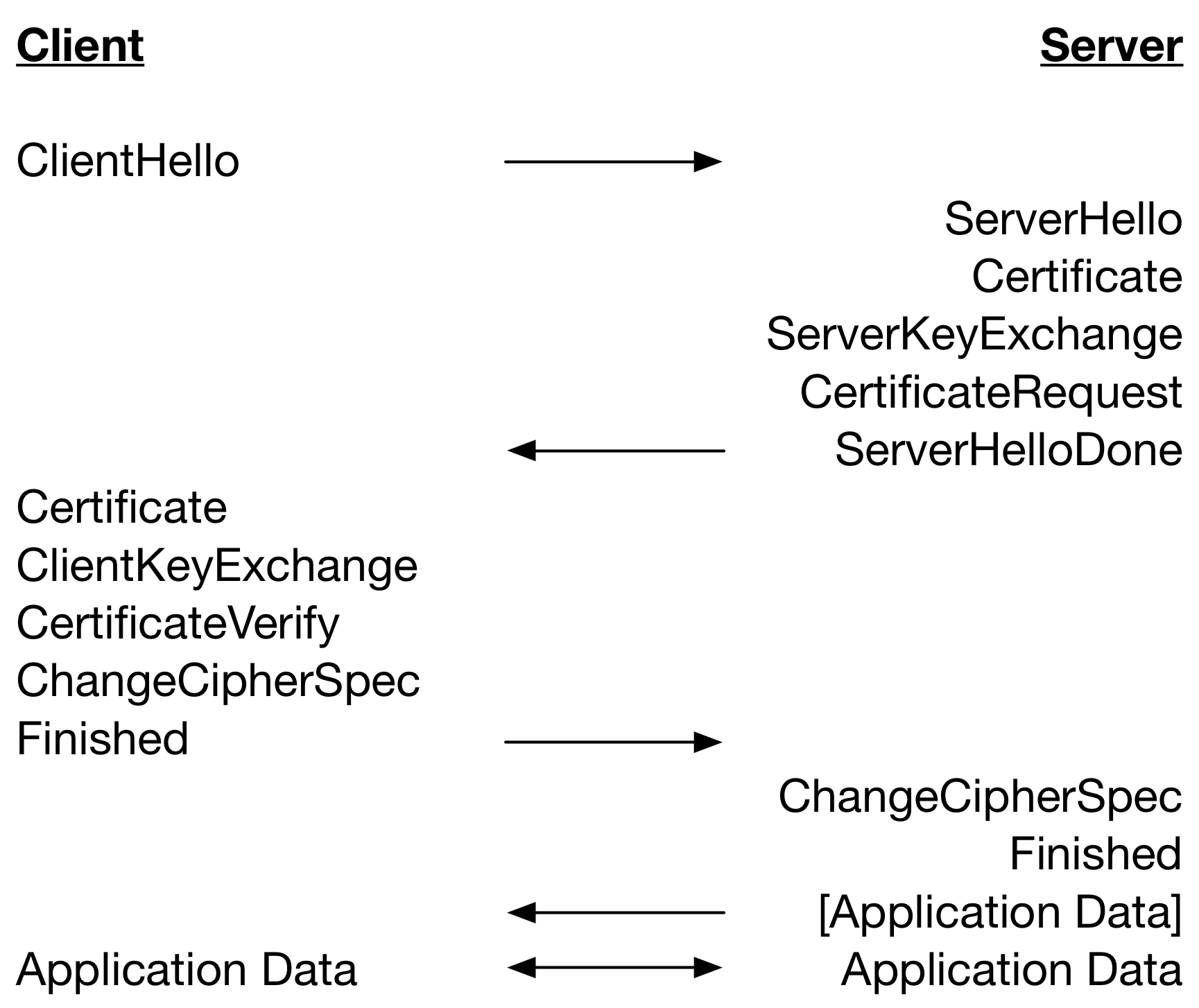
A TLS 1.3 full handshake (without HelloRetryRequest) performing client and server authentication with certificates is given below.
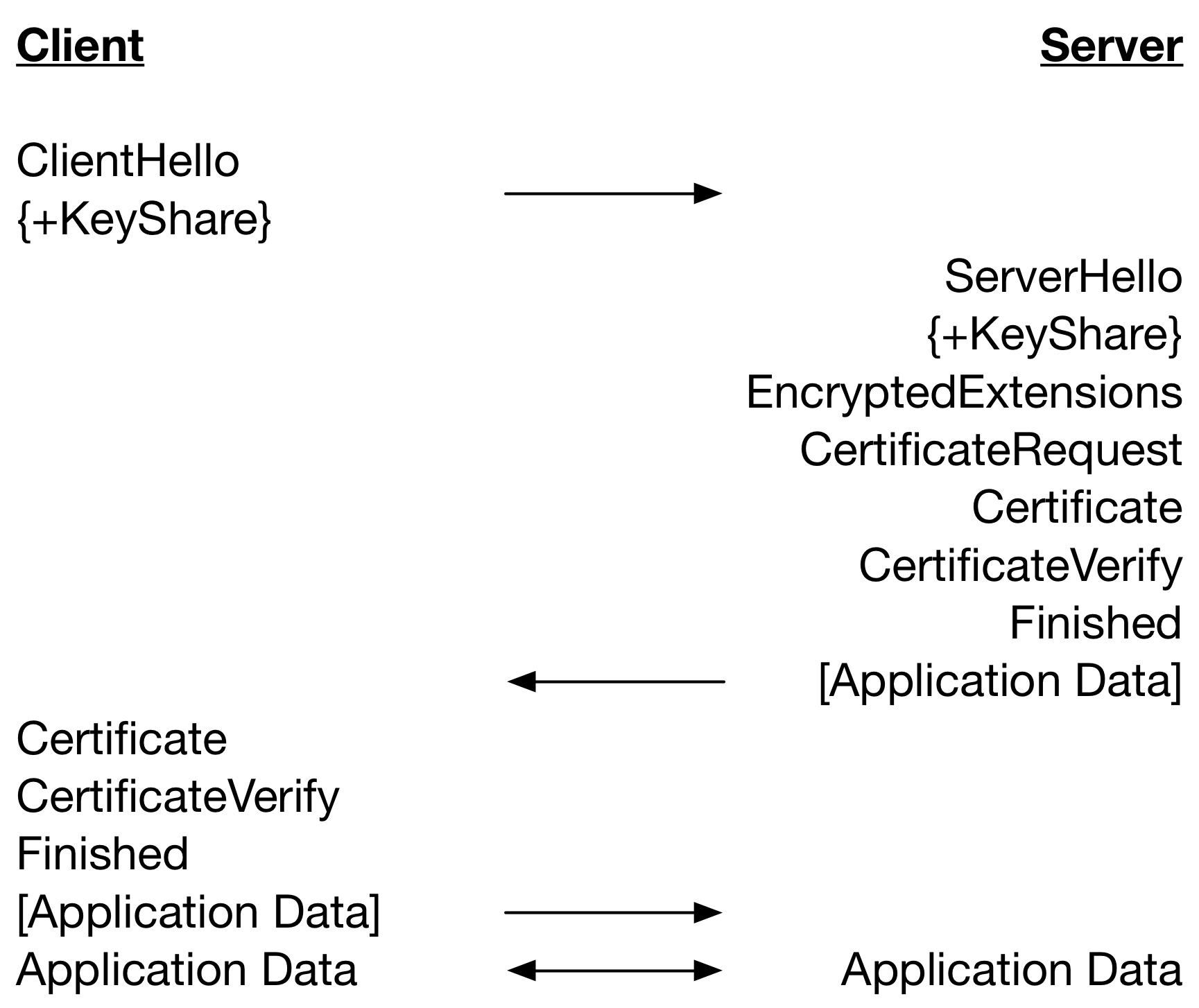
Notice that there is one less round trip until Application Data can be sent in TLS 1.3 as compared to TLS 1.2. This improves performance on high latency networks but there is a downside. What is clear in the diagram is when messages are sent but not how and when handshake messages are processed.
The table below restates the TLS 1.2 handshake, but includes the processing of messages and the major cryptographic operations that are performed. Operations are on the same line if the operations are performed at the same time relative to network latency.
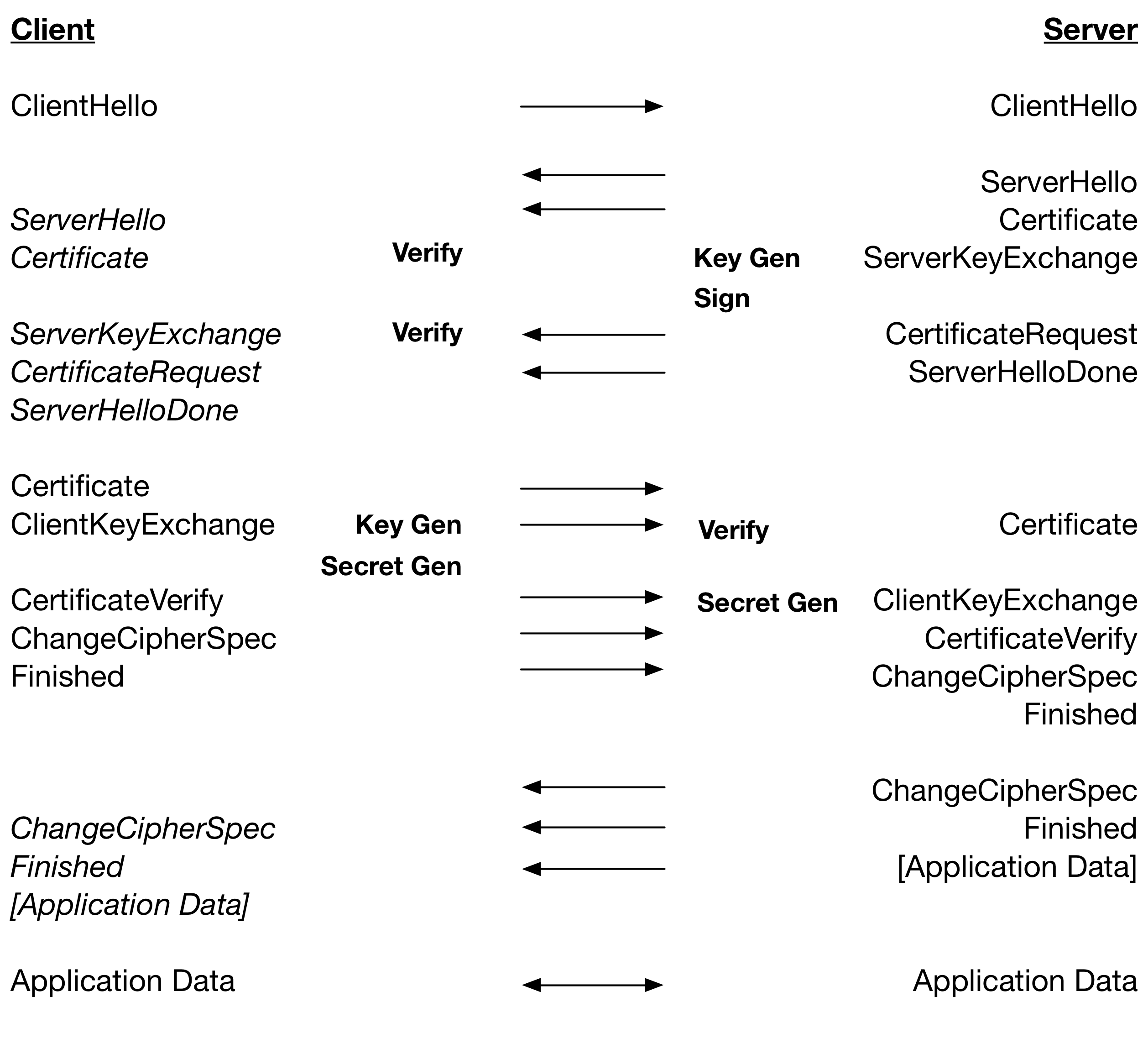
The server produces a KeyShare, sends the ServerHello, and then quickly sends the EncryptedExtensions, CertificateRequest and Certificate messages. The CertificateVerify takes a while to produce and the Finished message is quick. The client takes a while to process the KeyShare, quickly process the EncryptedExtensions and CertificateRequest messages, and spends a long time performing certificate chain verification. The CertificateVerify will typically arrive during the chain verification and then the client processes the rest of the messages synchronously. As a result, there is little overlap.
From this we can see that for RSA where Verify is very fast relative to Sign, a TLS 1.2 handshake is dependent on: 2 x Key Gen, 2 x Secret Gen, 1 x Sign and 2 x Verify. For ECDSA, where Verify is slower than Key Gen plus Sign: 1 x Secret Gen and 3 x Verify.
The table below restates the TLS 1.3 handshake, including processing of message and the major cryptographic operations.
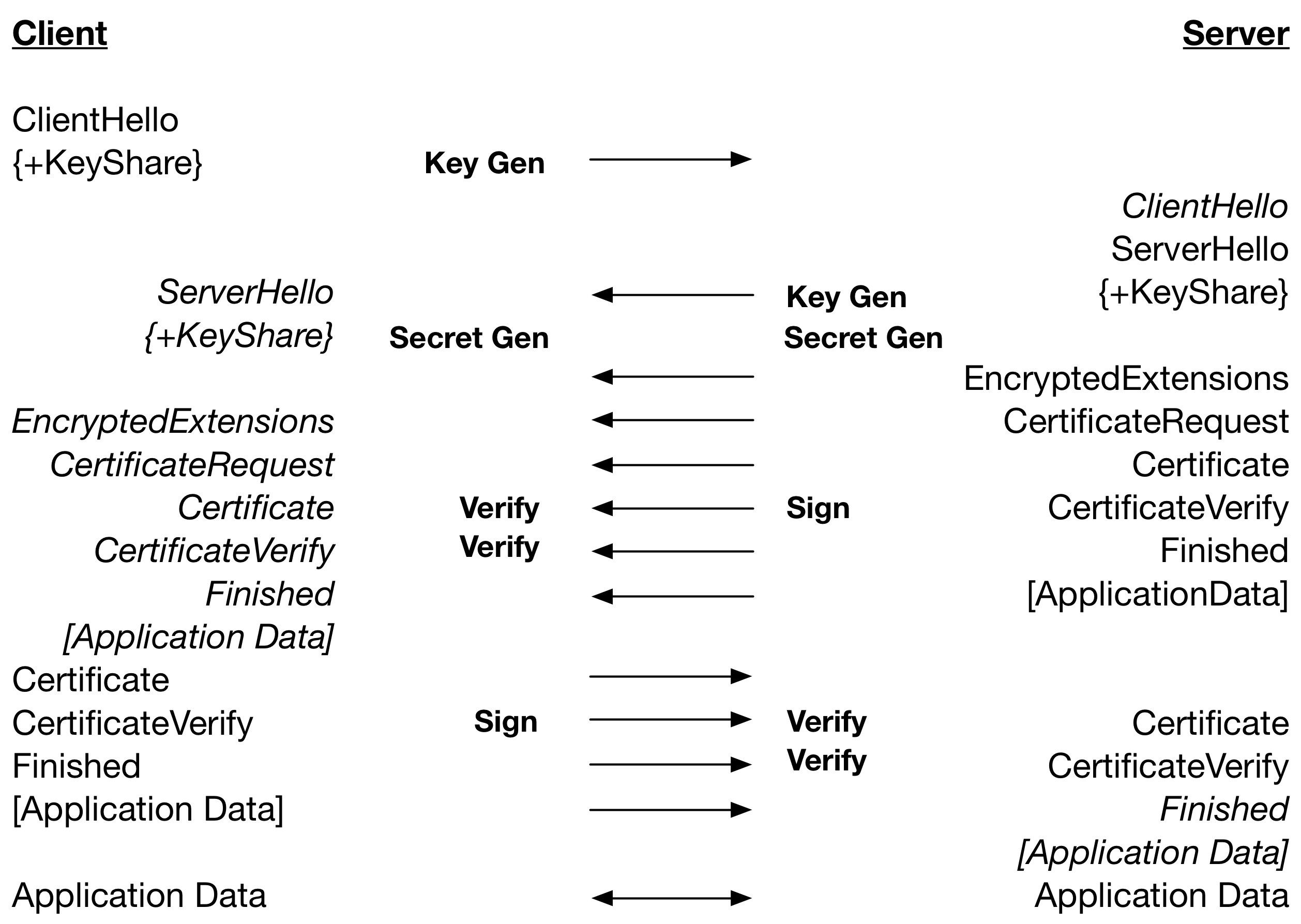
From this we can see that a TLS 1.3 handshake using RSA certificates is dependent on: 2 x Key Gen, 1 x Sercret Gen, 2 x Sign. Therefore a Secret Gen and 2 x Verify in TLS 1.2 are replaced with a Sign. Using ECDSA a handshake is dependent on: 2 x Key Gen, 1 x Sercret Gen and 4 x Verify. Therefore, a Secret Gen and Sign in TLS 1.2 is replaced by 2 x Verify.
This means that for low latency networks TLS 1.3 can be slightly slower or about as fast as TLS 1.2. The only practical mitigation for ECC certificates is to minimize the amount of work performed in chain verification. Having the server certificate stored on the client and/or the client certificate stored on the server will improve TLS 1.3 performance but at the risk of lower security.
The next blog will be the final one in this series and will discuss difference in throughput between TLS 1.2 and 1.3.
Part 1 (TLS 1.3 Performance – Resumption)
Part 2 (TLS 1.3 Performance – Full Handshake)
Part 3 (TLS 1.3 Performance – Pre-Shared Key (PSK))
Part 4 (TLS 1.3 Performance – Server Pre-Generation)
wolfSSL Apache Mynewt port
The wolfSSL embedded SSL/TLS library features many different ports, including one for Apache Mynewt. Apache Mynewt is a Real-Time Operating System (RTOS) that is used to build, deploy, and securely manage billions of devices. It is designed for IoT devices that have limited memory and storage and need to run for a long time with minimal power consumption. wolfSSL's port for Mynewt uses Mynewt's raw socket interface "mnsocket" to send and receive data through an SSL/TLS connection.
The wolfSSL port for Apache Mynewt is the ideal solution for security in your embedded IoT device. Apache Mynewt is an RTOS created with resource constrained devices in mind, and wolfSSL is an embedded SSL/TLS library created with speed, strength, portability, and low footprint size in mind. The combination of wolfSSL and Apache Mynewt results in a powerful security solution.
For more information, please contact facts@wolfssl.com.
wolfSSL also provides support for TLS 1.3, the most recent version of the TLS protocol!
Resources
wolfSSL release notes: https://www.wolfssl.com/docs/wolfssl-changelog/
Apache Mynewt homepage: https://mynewt.apache.org
Why They Use curl
authored by Daniel Stenberg - original post: https://gist.github.com/bagder/5970df691b7cdef65e95d3d48ebd8659
You most probably already know why you would use curl and if I'm right, you're also a fan of using the right tool for the job. But do you know why others use curl and why they switch from other solutions to relying on curl for their current and future data transfers? Let me tell you the top reasons I'm told by users.
Logging and exact error handling
What exactly happened in the transfer and why are terribly important questions to some users, and with curl you have the tools to figure that out and also be sure that curl either returns failure or the command worked. This clear and binary distinction is important to users for whom that single file every transfer is important. For example, some of the largest and most well-known banks in the world use curl in their back-ends where each file transfer can mean a transfer of extremely large sums of money.
A few years ago I helped a money transaction service switch to curl to get that exact line in the sand figured out. To know exactly and with certainty if money had been transferred - or not - for a given operation. Vital for their business.
curl does not have the browsers' lenient approach of "anything goes as long as we get something to show" when it comes to the Internet protocols.
Verbose goodness
curl's verbose output options allow users to see exactly what curl sends and receives in a quick and non-complicated way. This is invaluable for developers to figure out what's happening and what's wrong, in either end involved in the data transfer.
curl's verbose options allows developers to see all sent and received data even when encryption is used. And if that is not enough, it's SSLKEYLOGFILE support allows you to take it to the next level when you need to.
Same behavior over time
Users sometimes upgrade their curl installations after several years of not having done so. Bumping a software's version after several years and many releases, any software really, can be a bit of a journey and adventure many times as things have changed, behavior is different and things that previously worked no longer do etc.
With curl however, you can upgrade to a version that is a decade newer, with lots of new fancy features and old crummy bugs fixed, only to see that everything that used to work back in the day still works - the same way. With curl, you can be sure that there's an enormous focus on maintaining old functionality when going forward.
Present on all platforms
The fact that curl is highly portable, our users can have curl and use curl on just about any platform you can think of and use it with the same options and behaviors across them all. Learn curl on one platform, then continue to use it the same way on the next system. Platforms and their individual popularity vary over time and we enjoy to allow users to pick the ones they like - and you can be sure that curl will run on them all.
Performance
When doing the occasional file transfer every once in a while, raw transfer performance doesn't matter much. Most of the time will then just be waiting on network anyway. You can easily get away with your Python and java frameworks' multiple levels of overhead and excessive memory consumption.
Users who scan the Internet or otherwise perform many thousands of transfers per second from a large number of threads and machines realize that they need fewer machines that spend less CPU time if they build their file transfer solutions on top of curl. In curl we have a focus on only doing what's required and it's a lean and trimmed solution with a well-documented API built purely for Internet data transfers.
The features you want
The author of a banking application recently explained for us that one of the top reasons why they switched to using curl for doing their Internet data transfers, is curl's ability to keep the file name from the URL.
curl is a feature-packed tool and library that most likely already support the protocols you need and provide the power features you want. With a healthy amount of "extension points" where you can extend it or hook in your custom extra solution.
Support and documentation
No other tool or library for internet transfers have even close to the same amount of documentation, examples available on the net, existing user base that can help out and friendly users to support you when you run into issues. Ask questions on the mailing lists, post a bug on the bug tracker or even show your non-working code on stackoverflow to further your project.
curl is really the only Internet transfer option available to get something that's old and battle-proven proven by the giants of the industry, that is trustworthy, high-performing and yet for which you can also buy commercial support for, today.
wolfSSL Apache Port Coming Soon!
wolfSSL provides the wolfSSL embedded SSL/TLS library, which is a fast, secure, and highly portable implementation of the SSL/TLS protocols. As part of being highly portable, the wolfSSL library is frequently being ported to various other software modules and devices for users to easily implement wolfSSL's features. One of these more recent ports that wolfSSL has is a port to the Apache HTTP server project coming out soon!
Apache is an effort to develop and maintain an open-source HTTP server for modern operating systems including UNIX and Windows. Its goal is to provide a secure, efficient and extensible server that provides HTTP services in sync with the current HTTP standards. Using wolfSSL with Apache will also allow users to implement some of the other high profile features offered by wolfSSL, such as TLS 1.3 support, FIPS 140-2 validated code, and dual-licensed commercial support. wolfSSL also provides an OpenSSL compatibility layer, which can be easily used to switch from using OpenSSL's security to using wolfSSL's security.
For more information, please contact facts@wolfssl.com.
wolfSSL and the Zombie POODLE and GOLDENDOODLE Attacks
The wolfSSL library is NOT vulnerable to these attacks, thanks to previous fixes we've made and our extensive testing.
These attacks were presented by Craig Young at BlackHat Asia 3/29/2019 (slides).
Both attacks target the MAC and Padding used for TLS v1.2 with AES CBC cipher suites. TLS padding occurs when a record is not 16-byte aligned and is padded with the length value. The MAC uses HMAC with SHA/SHA256 to calculate an authention code. For TLS the order of operation is MAC -> PAD -> ENCRYPT.
The attack requires a man-in-the-middle (MITM) position to employ the attack. It takes valid records and alters either MAC or Padding or cause TLS errors. If the TLS server responds differently to each of these errors then it can leak information about the plain text message.
The author Craig Young wrote a "padcheck" tool, which tests the following error cases:
- Invalid MAC with Valid Padding (0-length pad)
- Missing MAC with Incomplete/Invalid Padding (255-length pad)
- Typical POODLE condition (incorrect bytes followed by correct length)
- All padding bytes set to 0x80 (integer overflow attempt)
- Valid padding with an invalid MAC and a 0-length record
For wolfSSL we respond consistently with the same alert and close the socket for each ofl these conditions.
The recommendation from the author is to stop using AES CBC cipher suites and start using TLS v1.3, which is supported by wolfSSL. More information about wolfSSL and TLS 1.3 can be found here: https://www.wolfssl.com/docs/tls13/
For more information about wolfSSL, please contact facts@wolfssl.com.
TLS 1.3 Performance Analysis – Server Pre-Generation
TLS 1.3 has some significant changes from TLS 1.2 that are targeted at performance. This is the fourth part of six blogs discussing the performance differences observed between TLS 1.2 and TLS 1.3 in wolfSSL and how to make the most of them in your applications. This blog discusses the server generating a key pair before the handshake starts.
As mentioned in the first blog in this series there is a way to mitigate some of the key exchange cost in TLS 1.3. If the server knows which key exchange algorithm will be used, it can preemptively generate a key pair after accepting a TCP/IP connection by calling wolfSSL_UseKeyShare(). In an architecture where both end-points are controlled by the same entity, a choice of security parameters, like the key exchange algorithm, is made upfront and can be relied on.
When directly connecting to a server, typically, a client only starts creating the ClientHello once a TCP/IP connection has been made. The server accepts the connection and waits for the client to generate a key share and send a ClientHello message. In this time, the server can also generate a key pair.
When using DH for key exchange this provides a significant saving as key generation is expensive. For example when using RSA for server authentication and running both client and server on the same computer, the connection is about 20% faster and with session reuse or PSK for server authentication, the connection is about 30% faster. For connections using ECDH with ECDSA for server authentication, the connection is only about 4% faster and with session reuse or PSK for server authentication, the connection is about 7% faster. EC key generation is very fast in optimised implementations and the impact of hiding its cost is therefore less.
Servers currently reuse the ephemeral key pair across multiple connections. It is common to regenerate the key pair once an hour up to once a day. This mechanism can be used instead of server pre-generation but at the cost of perfect forward security for the server.
If your architecture allows for it, the server should be implemented to generate the key pair after accepting a connection. For DH, it is well worth it. But even for ECDH the small performance improvement will result in more connections per second.
The next blog will discuss the performance issues with handshakes performing client-server authentication.
Part 1 (TLS 1.3 Performance – Resumption)
Part 2 (TLS 1.3 Performance – Full Handshake)
Part 3 (TLS 1.3 Performance – Pre-Shared Key (PSK))
TLS 1.3 Performance Analysis – Pre-Shared Key (PSK)
TLS 1.3 has a different handshake flow when using pre-shared keys and this impacts performance. This is the third part of six blogs discussing the performance differences observed between TLS 1.2 and TLS 1.3 in wolfSSL and how to make the most of them in your applications. This blog discusses how and why PSK handshakes are only similar in speed generally but faster when using DH style key exchange.
For TLS 1.2, handshakes using PSK are defined in a separate document (RFC 4279). In order to fit in with the existing flow, a full handshake is performed. In TLS 1.3, PSK handshakes are the same as resumption handshakes. Therefore there is one less round-trip required for TLS 1.3.
This change in flow has a significant impact on the performance of TLS 1.3. The amount of hashing and encryption/decryption has increased but losing a round-trip means that using PSK without a DH style key exchange is only slightly slower. On higher latency networks, the difference is trivial and the savings great.
In TLS 1.3 using DH or ECDH with PSK results in the following handshake operations.
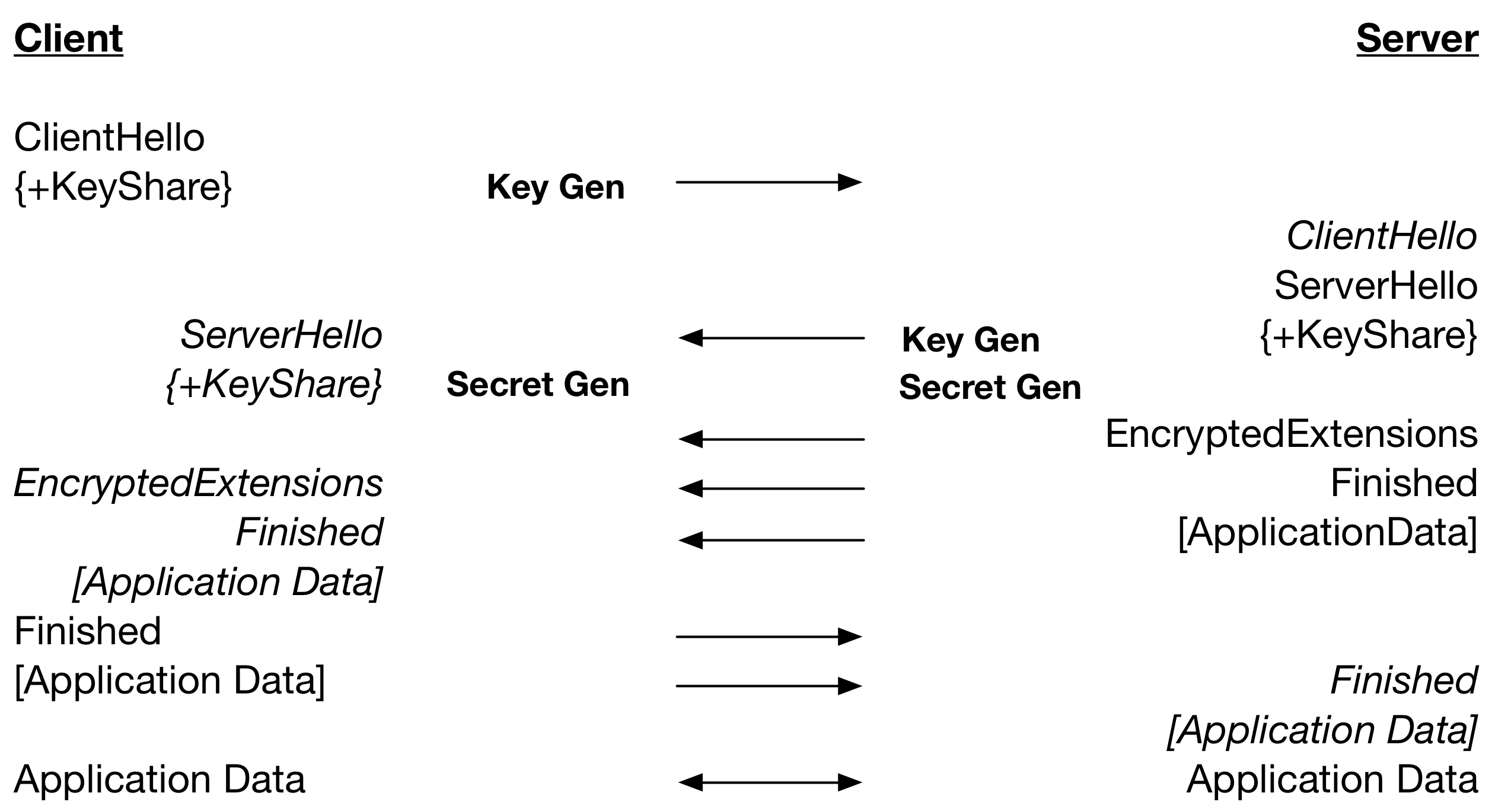
So, the secret is calculated on the server after the ServerHello is sent. This means that the processing of the ServerHello and secret calculation on the client is happening at the same time relative to the server calculating the secret. The parallel secret generation resulted in, with client and server running on the same computer, TLS 1.3 being about 25% faster than TLS 1.2 when using DH. Using ECDH with P-256, TLS 1.3 is about 15% faster.
It is clear that using pre-shared keys in a secure way, with DH style key exchange, is faster with TLS 1.3 in wolfSSL. The next blog will discuss use cases that result in the removal of a key generation from the list of expensive cryptographic operations in TLS 1.3.
Part 1 (TLS 1.3 Performance – Resumption)
Part 2 (TLS 1.3 Performance – Full Handshake)
For more information regarding wolfSSL performance or usage of PSK, please contact facts@wolfssl.com.
Weekly updates
Archives
- July 2025 (8)
- June 2025 (22)
- May 2025 (25)
- April 2025 (24)
- March 2025 (22)
- February 2025 (21)
- January 2025 (23)
- December 2024 (22)
- November 2024 (29)
- October 2024 (18)
- September 2024 (21)
- August 2024 (24)
- July 2024 (27)
- June 2024 (22)
- May 2024 (28)
- April 2024 (29)
- March 2024 (21)
- February 2024 (18)
- January 2024 (21)
- December 2023 (20)
- November 2023 (20)
- October 2023 (23)
- September 2023 (17)
- August 2023 (25)
- July 2023 (39)
- June 2023 (13)
- May 2023 (11)
- April 2023 (6)
- March 2023 (23)
- February 2023 (7)
- January 2023 (7)
- December 2022 (15)
- November 2022 (11)
- October 2022 (8)
- September 2022 (7)
- August 2022 (12)
- July 2022 (7)
- June 2022 (14)
- May 2022 (10)
- April 2022 (11)
- March 2022 (12)
- February 2022 (22)
- January 2022 (12)
- December 2021 (13)
- November 2021 (27)
- October 2021 (11)
- September 2021 (14)
- August 2021 (10)
- July 2021 (16)
- June 2021 (13)
- May 2021 (9)
- April 2021 (13)
- March 2021 (24)
- February 2021 (22)
- January 2021 (18)
- December 2020 (19)
- November 2020 (11)
- October 2020 (3)
- September 2020 (20)
- August 2020 (11)
- July 2020 (7)
- June 2020 (14)
- May 2020 (13)
- April 2020 (14)
- March 2020 (4)
- February 2020 (21)
- January 2020 (18)
- December 2019 (7)
- November 2019 (16)
- October 2019 (14)
- September 2019 (18)
- August 2019 (16)
- July 2019 (8)
- June 2019 (9)
- May 2019 (28)
- April 2019 (27)
- March 2019 (15)
- February 2019 (10)
- January 2019 (16)
- December 2018 (24)
- November 2018 (9)
- October 2018 (15)
- September 2018 (15)
- August 2018 (5)
- July 2018 (15)
- June 2018 (29)
- May 2018 (12)
- April 2018 (6)
- March 2018 (18)
- February 2018 (6)
- January 2018 (11)
- December 2017 (5)
- November 2017 (12)
- October 2017 (5)
- September 2017 (7)
- August 2017 (6)
- July 2017 (11)
- June 2017 (7)
- May 2017 (9)
- April 2017 (5)
- March 2017 (6)
- January 2017 (8)
- December 2016 (2)
- November 2016 (1)
- October 2016 (15)
- September 2016 (6)
- August 2016 (5)
- July 2016 (4)
- June 2016 (9)
- May 2016 (4)
- April 2016 (4)
- March 2016 (4)
- February 2016 (9)
- January 2016 (6)
- December 2015 (4)
- November 2015 (6)
- October 2015 (5)
- September 2015 (5)
- August 2015 (8)
- July 2015 (7)
- June 2015 (9)
- May 2015 (1)
- April 2015 (4)
- March 2015 (12)
- January 2015 (4)
- December 2014 (6)
- November 2014 (3)
- October 2014 (1)
- September 2014 (11)
- August 2014 (5)
- July 2014 (9)
- June 2014 (10)
- May 2014 (5)
- April 2014 (9)
- February 2014 (3)
- January 2014 (5)
- December 2013 (7)
- November 2013 (4)
- October 2013 (7)
- September 2013 (3)
- August 2013 (9)
- July 2013 (7)
- June 2013 (4)
- May 2013 (7)
- April 2013 (4)
- March 2013 (2)
- February 2013 (3)
- January 2013 (8)
- December 2012 (12)
- November 2012 (5)
- October 2012 (7)
- September 2012 (3)
- August 2012 (6)
- July 2012 (4)
- June 2012 (3)
- May 2012 (4)
- April 2012 (6)
- March 2012 (2)
- February 2012 (5)
- January 2012 (7)
- December 2011 (5)
- November 2011 (7)
- October 2011 (5)
- September 2011 (6)
- August 2011 (5)
- July 2011 (2)
- June 2011 (7)
- May 2011 (11)
- April 2011 (4)
- March 2011 (12)
- February 2011 (7)
- January 2011 (11)
- December 2010 (17)
- November 2010 (12)
- October 2010 (11)
- September 2010 (9)
- August 2010 (20)
- July 2010 (12)
- June 2010 (7)
- May 2010 (1)
- January 2010 (2)
- November 2009 (2)
- October 2009 (1)
- September 2009 (1)
- May 2009 (1)
- February 2009 (1)
- January 2009 (1)
- December 2008 (1)

